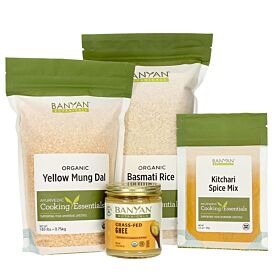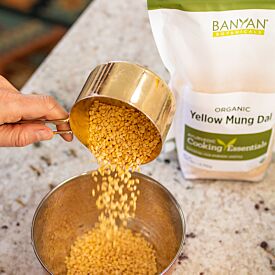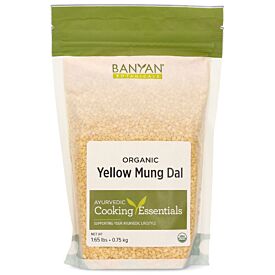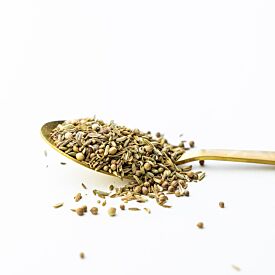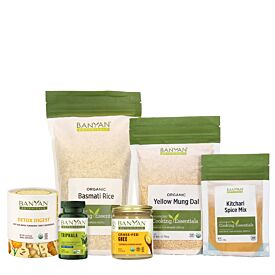An Introduction to Ayurvedic Cleansing
Do you ever feel just slightly off, but you can’t quite put your finger on what exactly is wrong? Or maybe it’s a more specific condition that’s disrupting your quality of life. These days, feeling lousy has almost become the norm. Too many of us are giving up on the possibility of ever feeling our best again.
Unfortunately, our cultural focus on diagnostic tools, treating symptoms, and labeling a wide range of ailments within tidy categories of disease is dulling our collective capacity for self-awareness and inner sensitivity.
As a result, many of us are ignoring our own internal alarm bells. In some ways, feeling crummy can be a blessing; at the very least, it is an important invitation. Why? Because it is at these early stages of being unwell—of feeling off, down, or hindered in some way—that we can correct our imbalances with the greatest ease. And even if you feel fantastic today, wouldn’t you prefer to stay that way?
This is why Ayurveda can be such a transformational force in our lives. Ayurveda literally means “the science of life” and it teaches us to tune into both the conspicuous and subtle indicators that there is room for improvement within—body, mind, and spirit.
The Ayurvedic tradition also offers us a myriad of diverse therapeutic strategies to actually achieve positive change, including tools to help us determine our baseline for health and current state of balance.
Ayurveda does not purport to offer any one-size-fits-all solution—no silver bullet to heal one and all. Instead, it teaches us how to better align with our truest inner nature and to reinvigorate our own innate intelligence in order to guide a very gentle and authentic healing process.
Your Digestive Fire
All of that said, Ayurveda does assert that there is one thing that influences our health more than any other: the metabolic fire—agni, in Sanskrit. Agni drives all processes of physiological transformation. It also:
- Turns food into consciousness and governs metabolism everywhere the body
- Governs digestion, absorption, and assimilation in the GI tract
- Oversees the exchange of nutrients at the cellular level—even the digestion of thoughts and emotions
- Is our number one defense system against ill health and disease.
Needless to say, when agni is impaired, our overall health suffers—sometimes in very overt and uncomfortable ways, other times, on much more subtle levels. If the concept of agni is new to you, you might appreciate reading The Importance of Healthy Digestion: An Ayurvedic Guide to Understanding Agni, which offers a more thorough introduction.
The point is that tending to and supporting the health of agni can be an impressive catalyst for improving overall health. And while there are many ways to support agni, a cleanse is one of the most straightforward and effective means available.
Done correctly, a cleanse strengthens agni throughout the system and helps eliminate the very toxicity that might otherwise inhibit it. A cleanse can therefore serve to initiate a powerful process of renewal and healing at many levels.
Indications
The following signs and symptoms are often an indicator that your body would benefit from a cleanse:
- You struggle with digestive difficulties of any kind
- You have intense cravings for spicy, salty, or sweet foods
- You tend to have trouble listening to what your body needs (in the way of sleep, food, rest, exercise, etc.)
- You frequently lack energy or feel exhausted
- You suffer from stress or feelings of anxiousness
- You have trouble sleeping or waking up
- Your mind feels scattered and you have trouble focusing
- You tend to feel foggy-headed or lethargic
- You sense a subtle and undefined malaise; you just don’t feel as well as you think you should (or maybe as well as you have in the past)
Benefits
At its core, an Ayurvedic cleanse is focused on drawing ama (natural toxins) and excess vata, pitta, and kapha out of the tissues and into the digestive tract so that they can be eliminated. While this is sometimes an uncomfortable process, the end result of a full body cleanse should be an improved sense of balance and overall health.
An Ayurvedic Cleanse Helps:
- Restore a sense of calm to the mind and the nervous system.
- Foster both clarity and groundedness in the mental, spiritual, and emotional spheres.
- Nurture an improved sense of energy, vitality, and enthusiasm for life.
- Support the maintenance of a healthy body weight.
- Restore and maintain balanced sleep cycles.
- Promote regular and balanced elimination.
- Recover each individual’s natural state of balance.
- Prepare the tissues for deep nourishment and rejuvenation.
- Promote optimal health.
Many Different Paths
Periodic cleansing is considered an important part of an Ayurvedic lifestyle, but the specific approach should always take into consideration one’s constitution and current state of balance (if you don't know yours, take our dosha quiz), strength, and age, as well as environmental and seasonal influences.
Thankfully, there are many different ways to go about the process, and there is generally something for everyone. The overall structure, length, intensity, and depth can all be adapted to support the individual.
Most Ayurvedic cleanses are centered around simplifying the diet and, in some cases, adding supportive lifestyle practices. The goal is to balance and strengthen agni and restore the body’s natural intelligence. These are powerful outcomes and they tend to reset our baseline health at very deep levels.
Remarkably, the process can be both curative and preventative because cleansing helps reinvigorate the body’s best internal defense mechanisms, as well as its capacity for repair and renewal. As a result, truly profound changes often follow even a simple cleanse.
Our cleansing department offers a smorgasbord of different cleanses so that individuals can choose the approach that best aligns with their personal needs, lifestyle, and available time.
Whatever cleanse is right for you, working with an Ayurvedic practitioner during a cleanse can provide an invaluable level of personalized support and can, in turn, amplify the benefits you’ll glean from the process.
You Can Do This
If you feel intimidated, or have doubts about how you’ll respond to the restrictions or the overall structure of a cleanse, please spend some time with the first couple of options described below. Some of the choices are truly quite simple and are meant to serve those of us who have never attempted any sort of cleanse before.
Also, keep in mind that the Ayurvedic approach to cleansing is typically built around a monodiet that includes whole grains, legumes, vegetables, ghee, many spices, and a wide variety of flavors. While your diet will be simplified, you will not be fasting. In fact, you will continue to enjoy tasty and satisfying meals, teas, complete proteins, and a balanced diet overall.
If you remain skeptical about how this process might serve you, we encourage you to give the most basic cleanse a try. Even if you don’t feel any early warning signs of imbalance, your body will very likely appreciate the break.
You may find yourself pleasantly surprised—even shocked—by how powerfully a cleansing regimen can support you and your overall health. And really, without our health, what else do we have?
A periodic cleanse is one of the most valuable gifts we can offer ourselves. In the modern era, when so many of us are overly busy, overly toxic, and consistently weighed down by stress, a cleanse can be life-changing.
Freedom in Variety
One of the most elegant aspects of the Ayurvedic approach is that it is able to meet each of us exactly where we are. Some forms of cleansing are quite intense, require a certain amount of strength, and should only be practiced at specific times of the year. Other approaches are extremely simple, very gentle on the body, and are appropriate for most people.
That said, even the most basic cleanse has some contraindications. For instance, cleansing is generally not appropriate for pregnant or breastfeeding women. This is simply not the time to be clearing the tissues or stirring toxins into circulation.
We’ve included a list of contraindications for each of the cleanses described below, so please review those carefully before you make a decision about which approach is right for you.
Time Commitment
It is also important to realize that the longer and deeper a cleanse is, the more delicate the body is likely to become during the process, and the more care and attention will be necessary in order to “return to normal” afterward.
When it comes to selecting an appropriate cleanse, this is actually one of the most important considerations. You’ll want to be careful to choose a very manageable timeframe and overall level of commitment in order to set yourself up for success.
If you are new to cleansing, we highly recommend choosing a shorter, simpler approach in order to get a feel for how you do with the discipline of a cleanse. You can always graduate to a more in-depth cleanse the next time.
However, if you are highly motivated to dive straight into a longer, deeper cleanse, we’ve done our best to clearly outline the structure and expectations there as well.
The Options
Below, you will find a brief description of several different approaches to cleansing—from the shortest, most basic method, to the longest, most in-depth option (in that order). We recommend reading each of the descriptions below in order to determine which options feel the most appropriate for your situation.
You can then follow the links to read detailed instructions for any of them. We hope that this resource proves helpful in selecting a cleanse that will work for you at this time.
One-Day Digestive Reset
This short, one-day routine is not a cleanse, per se, but is a great opportunity to support agni on a more regular basis. The digestive reset is designed to kindle agni and clear surface ama by encouraging the light, clear, and subtle qualities with a one-day monodiet.
The diet itself can be adapted to your particular needs. The most universally appropriate approach is to eat kitchari (basmati rice and mung dal) for a day, but for some individuals, a day of fruit or juice might be suitable.
Whatever the case, this approach works by very briefly cleaning up the diet in order to clear toxins and imbalances from the digestive tract while strengthening the digestive fire for improved performance. This routine provides a simple but effective means of supporting agni—especially if the reset is practiced on a regular basis.
Consider this approach if:
- Your digestion could use a somewhat regular boost.
- You recognize and believe in the power of slow, steady progress.
- You want to be proactive about clearing your body of any harmful influences.
- You would like to offer your system more frequent support than an occasional cleanse.
- You find a simple approach more appealing and are willing to consider enacting these protocols on a routine basis.
- You are not sure you have the time or endurance for a longer cleanse, but can commit to a one-day monodiet every so often (weekly, monthly, seasonally, etc.).
This approach is NOT for you if:
- You are extremely weak, debilitated, or convalescing.
- You are pregnant or breastfeeding. In this case, a one-day kitchari reset may be appropriate, but you should consult with your health care provider or Ayurvedic practitioner first.
If this approach sounds appealing to you, please see our detailed instructions for doing a One-Day Digestive Reset.
Simplified Three-Day Cleanse
This entry-level, three-day cleanse is appropriate at any time of year and is designed to rest and reset the digestive tract in the shortest amount of time possible. Because it is so brief and does not involve an extensive list of practices beyond the dietary protocols, this approach is generally a wonderful introduction for anyone new to cleansing.
Based on a very simple diet of whole grains and kitchari, this cleanse is complemented by detoxifying fluids and supportive herbs. Like the digestive reset, this process kindles agni and clears ama by encouraging the light, clear, and subtle qualities, but it goes deeper than the one-day digestive reset can.
This three-day cleanse affords the body an important break from the harmful inputs that we typically ingest each day, giving agni a chance to rest, recuperate, and repair itself while encouraging the body’s natural mechanisms of detoxification.
Overall, this cleanse helps to kindle the digestive fire, strengthen the digestive capacity, burn accumulated ama, and clear excess vata, pitta, and kapha from the digestive tract.
It can also be profoundly clarifying for the mind and the tissues. In just three days, you will likely notice an enhanced sense of taste as well as marked improvements in your appetite, digestion, elimination, and mental clarity.
Consider this approach if:
- You want to experience the benefits of a stronger digestive fire and a clearer mind.
- You feel ready to tackle more than a one-day digestive reset, but simplicity feels like the right energy to bring to your cleansing process at this time.
- You are new to cleansing and want to experience the benefits of an Ayurvedic cleanse, but you also want to start small.
- You have experience cleansing but want to focus on a short, food-based cleanse at this time (without many other requirements).
- You feel excited about committing three days of your life to the process of cleansing.
This approach is NOT for you if:
- You are extremely weak, debilitated, or convalescing.
- You are pregnant, breastfeeding, or menstruating.
If this approach sounds appealing to you, please see our detailed instructions for doing a Simplified Three-Day Cleanse.
Traditional Ayurvedic Cleanse
(Flexible Timeframe: Three to Twenty-One Days)
In general, this cleanse is more involved, requires a bit more commitment, and, ideally, is done at a time when you have cleared your schedule in advance. That said, this cleanse can be done entirely at home and there is a great deal of flexibility in the basic structure.
The length of this cleanse can be anywhere from three to twenty-one days, and the cleanse can include a number of supportive lifestyle practices or just a few—depending on what feels the most doable and nourishing to you at this time.
Understandably, the longer the cleanse, and the more supportive practices you are willing to take on, the deeper the benefit will be. While this style of cleanse is workable at any time of year, it is the most beneficial at the junctions between seasons—and in particular, around the onset of spring and autumn.
This cleanse involves three distinct phases—preparation, active cleansing, and reintroduction—which are then followed by a period of rejuvenation. This structure helps to ease the body both into and out of the cleanse, and offers deep nourishment to the tissues afterward.
Much like the options outlined above, the diet consists primarily of whole grains, kitchari, and vegetables, and is supported by detoxifying herbs and teas.
However, this cleanse is complemented by practices such as self-massage with oil, gentle sweating, and the administration of herbal nose drops—all of which help loosen and release imbalances held in the tissues. Therefore, this cleanse has the capacity to initiate a slightly deeper level of detoxification.
The length of this cleanse is entirely up to you. For most people, the best results are experienced with an average length of nine to fifteen days. Keep in mind that the active cleansing phase is the most intense, but it makes up only one-third the total length of the cleanse (e.g., for a fifteen-day cleanse, the active cleansing phase is just five days).
As we’ve said, you can also pick and choose which additional lifestyle practices feel the most important for you to observe during this phase of the cleanse.
Active cleansing encourages rest and repair in the digestive tract, kindles agni, and serves to loosen and expel excess vata, pitta, kapha, and ama from the system. After this phase is complete, the slow, gentle transition to a more diverse diet helps to preserve the newfound strength of the digestive fire and encourages the continued elimination of any impurities stirred to the surface during the cleanse.
Participants typically finish this cleanse feeling lighter, clearer, and more attuned to their body’s innate intelligence—with improved digestive strength, healthier elimination, and an abiding sense of mental clarity.
Consider this approach if:
- You are motivated to commit to a longer, more involved cleanse in order to experience deeper benefits.
- You are capable of maintaining a disciplined diet and schedule for the length of your cleanse.
- You are willing to dedicate at least some time off to your cleansing process—in particular, to the active cleansing phase.
- You are new to cleansing but are highly motivated and feel you have the self-discipline to start with a more involved cleanse.
- You want to get the most out of an at-home detox program and are ready to do whatever it takes to support your body through the process.
- You feel excited about making a deep commitment to yourself, your body, and to the process of cleansing; cleansing is a high priority for you right now.
This approach is NOT for you if:
- You are extremely weak, debilitated, or convalescing.
- You are pregnant, breastfeeding, or menstruating.
If this approach sounds appealing to you, please see our detailed instructions for doing a Traditional Ayurvedic Cleanse.
Panchakarma
Panchakarma (PK) is Ayurveda’s signature cleanse. It is undoubtedly the most involved of the options listed here. In fact, it is such an elaborate and individualized process that it truly requires the involvement of an experienced practitioner.
While we will not provide instructions for doing panchakarma, we did want to offer an overview of the process, so that you can appreciate what distinguishes this approach from those outlined above. Panchakarma is inherently seasonal; it should not be done in the summer or winter and is best done around the time of the fall or spring equinox. The length of a PK program can vary according to the needs of the individual.
On the surface, panchakarma looks very similar to other cleanses we’ve discussed here; it aims to loosen and eliminate excess vata, pitta, kapha, and ama from the system, and a monodiet of kitchari plays a central role in that process. But there is one very significant difference, and that is that panchakarma reverses the flow of nutrition in the body. Normally, nutrition flows from the digestive tract into the bloodstream, and from there, into the tissues.
During PK, we intentionally smother the digestive fire and reverse the direction of that flow, allowing toxins and impurities to move from the deep tissues, into the bloodstream, and back to the digestive tract where they can more easily be eliminated. While this occurs in other Ayurvedic cleanses on a superficial level, PK intensifies the process in order to cleanse impurities from the very deepest layers of the body.
This is why panchakarma is such a potent cleanse. However, this disruption to the flow of nutrients in the body necessitates a great deal of care after PK is complete in order to return things to normal.
Panchakarma can be done at home, in a residential or retreat setting, or somewhere in between. Typically, the less that is required of the participant, the deeper the detox will be. This being the case, a residential program is ideal, if it is available to you.
However, a home panchakarma, or a combination of home and professional treatments, can be very successful and satisfying as well. Panchakarma should always be done under the guidance of an experienced practitioner.
You may want to look into panchakarma if:
- You really want to engage with the deepest Ayurvedic cleanse available.
- You have the physical strength to undergo a very deep internal reset.
- You can afford to take dedicated time off in order to pursue a cleanse.
- You want the best possible outcomes for your time.
- Cleansing your body is of the utmost importance to you.
This approach is NOT for you if:
- You are pregnant, breastfeeding, or menstruating.
- You are under the age of eight.
- You are very elderly.
- You are at all weak, debilitated, or in the process of convalescing.
- You suffer from chronic consumption.
- You have heart disease with complications.
- You have a severe bleeding disorder.
- You are currently undergoing chemotherapy or radiation therapy (although you are welcome to discuss when panchakarma would be appropriate with a qualified Ayurvedic physician).
- You do not have a qualified Ayurvedic practitioner or panchakarma center to guide you.
Trust Yourself
While cleansing can be profoundly beneficial, it is very important to honor your own process and timing. Remember, Ayurveda aims to meet each of us exactly where we are. We are all capable of experiencing the benefits of an Ayurvedic cleanse, even if we are not ready for panchakarma.
Start where you are, and give yourself permission to start small, and to progress at your own pace. Perhaps most importantly, seek support wherever you need it. One of the rewards of honoring ourselves as we engage with a cleansing process (however simple) is that it gets easier with time.
Inevitably, as our overall state of balance improves, and as the intelligence within our bodies resurfaces, these cleansing therapies become more and more natural, easeful, and rewarding. So, start with whatever steps feel right to you today and trust that you are exactly where you need to be.
We hope that we can continue to support you on your journey with Ayurveda and on your quest for improved health.




